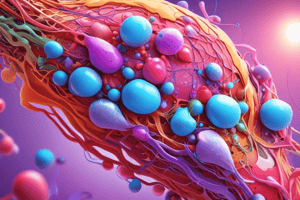Podcast
Questions and Answers
Which of the following classes of hormones include examples like insulin and growth hormone?
Which of the following classes of hormones include examples like insulin and growth hormone?
- Lipid derivatives
- Amino acid derivatives
- Protein derivatives (correct)
- Steroid hormones
The endocrine system communicates using electrical impulses, similar to the nervous system.
The endocrine system communicates using electrical impulses, similar to the nervous system.
False (B)
What is one primary role of the hypothalamus in the endocrine system?
What is one primary role of the hypothalamus in the endocrine system?
It regulates the secretion of hormones from the pituitary gland.
The process by which an increase in hormone levels leads to a decrease in its production is called ______.
The process by which an increase in hormone levels leads to a decrease in its production is called ______.
Match the following glands with their primary function in the endocrine system:
Match the following glands with their primary function in the endocrine system:
What is the primary function of prostaglandins in circulation?
What is the primary function of prostaglandins in circulation?
Aspirin enhances the production of prostaglandins.
Aspirin enhances the production of prostaglandins.
What are the two main lobes of the thyroid gland responsible for releasing?
What are the two main lobes of the thyroid gland responsible for releasing?
The adrenal glands are located on top of the __________.
The adrenal glands are located on top of the __________.
Match the glands with their primary functions:
Match the glands with their primary functions:
Which type of communication occurs within the same cell?
Which type of communication occurs within the same cell?
Neurotransmitters are used in the endocrine system.
Neurotransmitters are used in the endocrine system.
What are eicosanoids derived from?
What are eicosanoids derived from?
Endocrine communication primarily uses _____ to relay messages.
Endocrine communication primarily uses _____ to relay messages.
Match the following types of hormones to their respective classes:
Match the following types of hormones to their respective classes:
What is the primary characteristic of the nervous system compared to the endocrine system?
What is the primary characteristic of the nervous system compared to the endocrine system?
Steroid hormones are primarily released by the reproductive organs.
Steroid hormones are primarily released by the reproductive organs.
What are the two classes of lipid derivatives mentioned?
What are the two classes of lipid derivatives mentioned?
Study Notes
Intercellular Communication
- Communication between cells is essential for coordination and function within the body
- Four main types: direct, paracrine, autocrine, and endocrine
Endocrine System
- Key characteristics:
- Hormones released into the bloodstream
- Acts on target cells with specific receptors
- Long-lasting effects compared to the nervous system
- Differences from the Nervous System:
- Nervous system: targets specific cells, short-lived action
- Endocrine system: reaches nearly all cells, long-lasting effects
Classes of Hormones
- Three main classes:
- Amino acid derivatives: modified amino acids, including thyroid hormones and catecholamines
- Peptide hormones: chains of amino acids, examples include insulin, glucagon, and growth hormone
- Lipid derivatives:
- Eicosanoids: paracrine signaling molecules derived from arachidonic acid
- Steroid hormones: derived from cholesterol, examples include testosterone, estrogen, and cortisol
Hormone Transport and Inactivation
- Hormones released directly into capillaries
- Rapid distribution throughout the body via circulation
- Inactivation mechanisms:
- Binding to target cell receptors
- Absorption or breakdown by cells, liver, or kidneys
- Breakdown by enzymes
Hormone Receptors and Action
- Hormones can either cross cell membranes or not
- Direct activation: hormones that cross the membrane directly activate cell function (first messenger action)
- Second Messenger Action: hormones that cannot cross the membrane rely on second messengers (G-protein) to trigger cellular responses
Pituitary Gland
- Two main parts:
- Anterior Pituitary: releases hormones controlled by the hypothalamus
- Posterior Pituitary: releases hormones synthesized in the hypothalamus
Thyroid Gland
- Ductless gland located inferior to the larynx
- Two lobes
- Releases thyroid hormones (T3 and T4)
- Receptors found in the cytoplasm, mitochondria, and nucleus
- T3 and T4 increase ATP production in mitochondria
Adrenal Glands
- Also known as suprarenal glands
- Small, triangular-shaped glands located on top of both kidneys
- Produce various hormones, including corticosteroids and catecholamines
Studying That Suits You
Use AI to generate personalized quizzes and flashcards to suit your learning preferences.
Related Documents
Description
Test your knowledge on the intercellular communication and endocrine system. Explore the main types of cellular communication and understand the classes of hormones and their functions. Discover the differences between the endocrine and nervous systems while delving into hormone action.




